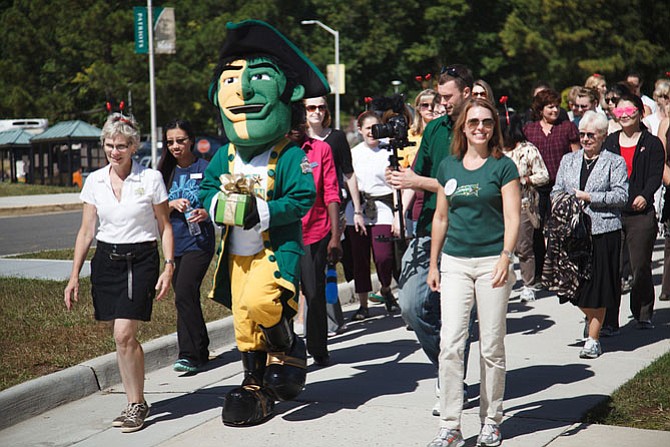Staff, students and faculty at George Mason University take part in “Who’s Walking Wednesdays,” an effort to increase physical activity and well-being. Research shows that workplace health programs can lead to increased productivity. Photo Courtesy of George Mason University
It’s Wednesday afternoon and a cohort of George Mason University staff, students and faculty hit the pavement. Clad in attire ranging from running shorts and brightly colored sneakers to neutral walking shoes and business suits, the group takes part in “Who’s Walking Wednesdays,” part of an initiative to get moving for health and wellness.
“It’s really important to connect faculty and staff into well-being and wellness practices,” said Janet Walker, life/work connections manager at George Mason University. “It benefits everybody in terms of their own personal health and wellness. It creates a community where people interact over more than just work.”
The effort underscores the role of workplace health and fitness programs can play in decreasing stress and improving overall well-being. A National Institutes of Health study of more than 29,000 employees who participated in comprehensive workplace health programs that included components such as fitness, weight control and smoking cessation, showed a 14-percent decline in illness over a two-year period, as well as a six-percent increase in productivity.
Workplace health programs can also consist of health education, fitness programs, health coaching and screenings.
“There’s all sorts of research about how time spent outdoors and taking walking breaks at work fosters creativity and problem solving,” said Jeanne Bliss, director of marketing, Center for the Advancement of Well-being at George Mason.
Bliss says university officials hope to impact the well-being of 10 million people within the next four years through the center. “We want to be a replicable model for well-being,” she said. “That has been one of our strategic 10-year goals.”
“We’re in a position to help the next generation in terms of how they connect with their own workforce in terms of health and well-being,” said Brandice Valentino, director of well-being programs and mindful living coordinator at the Center for the Advancement of Well-being. “Our programs focus on topics for well-being and integrating mindfulness practices.”
Amy K. Turner, executive director of Innovation Health, a Northern Virginia health insurance company formed as a result of a partnership between Aetna and Inova, says her company has improved the health of its workforce through tailored employee wellness programs.
Innovation Health has also created corporate wellness programs for its corporate clients. In fact, the company received the Loudon Chamber of Commerce Healthy Business Award, which honors the winners of the Loudon Healthy Business Challenge, a competition designed to recognize Northern Virginia businesses that have improved the health of their workforce through tailored employee wellness programs.
A group mentality is one of the keys. Group fitness activity can lead to success, say experts. “I feel like when you do it in a group and you’re part of a group, you’re more committed,” said Turner. “It holds people accountable and promotes success.
“Our ‘Get Active Challenge’ is where employees set fitness goals and challenge other teams within their corporation,” she said. “It engages employees to work together in teams, challenges them. We’ve found that it improves employee satisfaction.”
